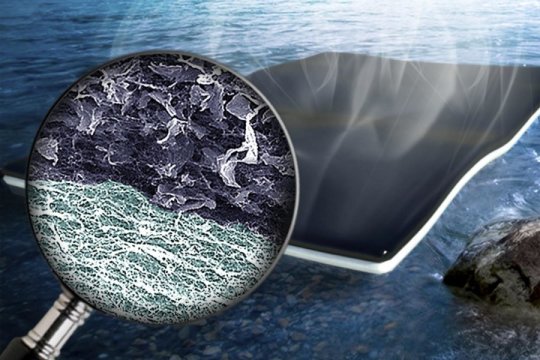New Mix of Nanomaterials Could Transform Millions of Lives

An artist’s rendering of nanoparticle biofoam that makes it possible to clean water quickly and efficiently. Credit: Washington University in St.Louis
ScienceDaily.com reports that a team of engineers working at Washington University in St. Louis have discovered how to use graphene oxide sheets to turn dirty water into clean drinking water.
[See STEMRules related gallery of Environmental Activists]
The breakthrough combines bacteria-produced cellulose and sunlight-absorbing graphene oxide to form a bi-layered biofoam that acts like a sponge creating evaporation that transforms dirty water to clean.
Srikanth Singamaneni, an associate professor of Mechanical Engineering and Materials Science at the School of Engineering & Applied Science said, “We hope that for countries where there is ample sunlight, such as India, you’ll be able to take some dirty water, evaporate it using our material, and collect fresh water”
Explanation:
Graphite is a three-dimensional carbon-based material composed of millions of layers of graphene, which is a sphere of bonded carbon atoms in sheet form one atom thick.
TheGuardian.com describes graphene as “the strongest, lightest, most conductive material in the world, 200 times tougher than steel, more flexible than rubber, and almost totally transparent.”
Graphene oxide is a reduction of grapheme, using oxidizing agents, that expands its layer separation making it hydrophilic or dispersable in water

Sirimuvva Tadepalli – Credit: Washington University in St. Louis
Sirimuvva Tadepalli is a member of the team that developed the nanoparticle bio. She is a fourth-year IMSE doctoral student working on the interface between nanoparticles and proteins in the lab of Dr. Singamaneni.
Tadepalli will receive her PhD in Material Science and Engineering in 2017. She has a BTech degree in Metallurgical and Materials Engineering from the National Institute of Technology Warangal in India.
Journal Reference:
- Qisheng Jiang, Limei Tian, Keng-Ku Liu, Sirimuvva Tadepalli, Ramesh Raliya, Pratim Biswas, Rajesh R. Naik, Srikanth Singamaneni. Bilayered Biofoam for Highly Efficient Solar Steam Generation. Advanced Materials, 2016; DOI: 10.1002/adma.201601819
Tags: bioengineering, nanotechnology,







